Previous Post Next Post
Thursday, March 12th, 2009
The Green Light Tour
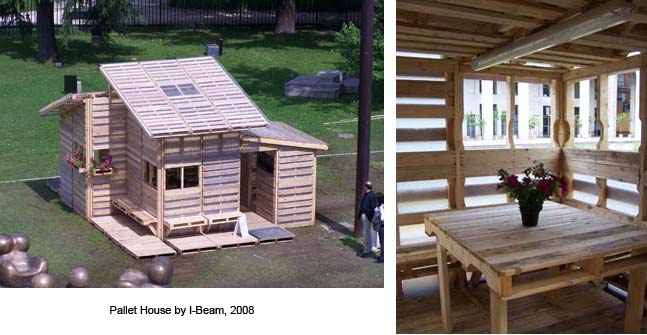
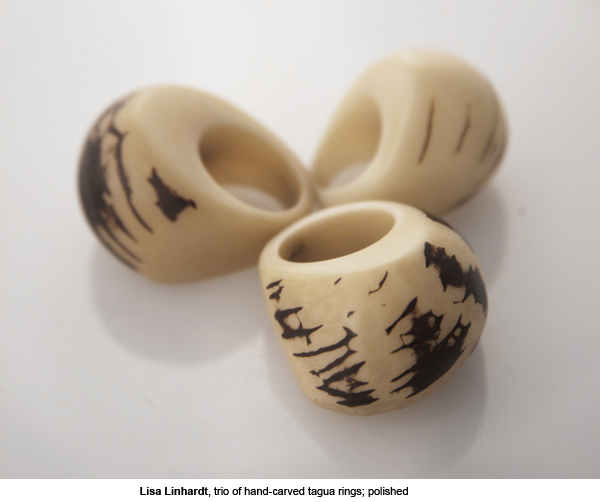
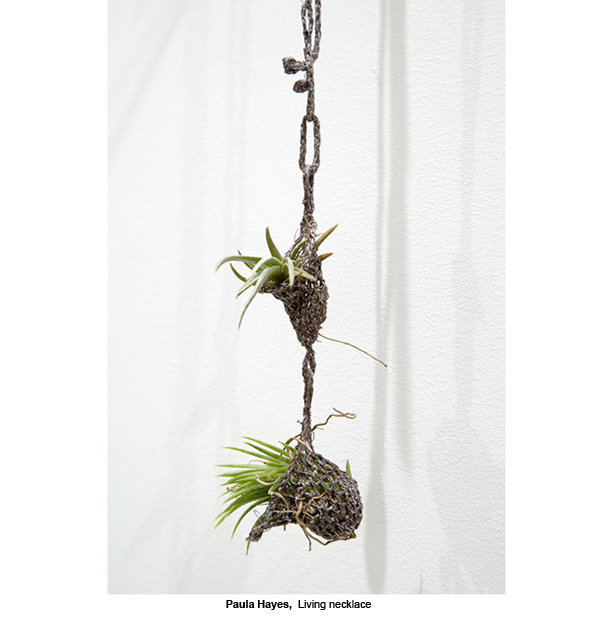

by artist correspondent Eva Mantell
On Saturday February 7th, 2009, a small group from the Arts Council of Princeton set off with me to New York City to explore green art and design. Picture us all driving in an ordinary, smog-producing van from New Jersey through a tunnel and emerging into an imaginary world, the green city, a model of sustainable living, with organic gardens growing up the sides of friendly buildings and clean streets filled with cheerful, creative citizens.
This week Steven Chu, Secretary of Energy, Nobel-Prize Winner, physicist, was interviewed in the New York Times and let it be known from the top down that we need a revolution in science and technology. We need replacements for fossil fuels and new ways to curb CO 2 emissions. Solar needs a serious upgrade. Alternative fuels and clean ways to burn coal need to be invented PRONTO. We knew this, but now you know it too.
Calling all engineers, P.H.D’s, politicians and investors: start small, start big, be brilliant, talk amongst yourselves, make it happen, and then lay it on us. We’ll take one in every color.
We, the consumers. What exactly are our obligations towards being sustainable, when we don’t have enough green to invest in green updates, and to buy those green treats? What’s happening to the dream when everything is tasting so stale right about now?
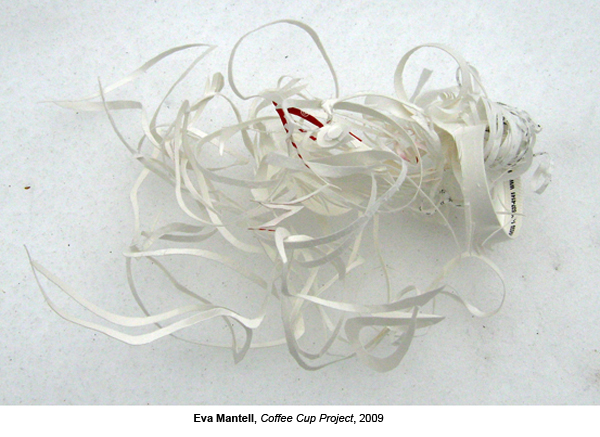 The environment has been on my mind for about 20 years now. For quite a while I have been making my own art out of broken umbrellas, the mail, magazines and other abject ingredients, including most recently, paper coffee cups. Seeing that those paper cups we throw away are in effect a group environmental sculpture anyway, on view at your local landfill. I thought I’d see what I could do with this vessel, this little disposable grail that has known the human touch and taste of human lips. I took a few photos of some pieces in the snow that fell last week, putting the coffee cups back on the ground where they were headed anyway. Finding what is human in these things, finding something new to do with them, is now eagerly called “recycling in art,” which my literal mind says ought to be taking old paintings or sculptures and grinding them up into new ones, or something like that (not a bad idea!). My own use of the stuff around me presents a situation where a particular material is being asked to behave in a way that argues against its original utility. It’s not literal recycling, but a lament for our relationship to the environment.
The environment has been on my mind for about 20 years now. For quite a while I have been making my own art out of broken umbrellas, the mail, magazines and other abject ingredients, including most recently, paper coffee cups. Seeing that those paper cups we throw away are in effect a group environmental sculpture anyway, on view at your local landfill. I thought I’d see what I could do with this vessel, this little disposable grail that has known the human touch and taste of human lips. I took a few photos of some pieces in the snow that fell last week, putting the coffee cups back on the ground where they were headed anyway. Finding what is human in these things, finding something new to do with them, is now eagerly called “recycling in art,” which my literal mind says ought to be taking old paintings or sculptures and grinding them up into new ones, or something like that (not a bad idea!). My own use of the stuff around me presents a situation where a particular material is being asked to behave in a way that argues against its original utility. It’s not literal recycling, but a lament for our relationship to the environment.
But it’s fair to say you can recycle in jewelry, as mining new metals actually pollutes a great deal, and you can literally melt down old pieces to make new ones. Meet Lisa Linhardt, a young jewelry designer in the East Village, whose entire M.O. embodies environmental and socially conscious principles. From her artful, salvaged display cases to her reuse of metals from existing pieces to her support of education and the arts in the developing world, she really embodies a new approach. The jewelry is cool and lovely and the old anthropologist in me practically had a cow when I saw her carving tagua nuts into rings. These nuts apparently drop from trees in the rain forests of Ecuador and are an eco-friendly substitute for ivory. I might have to get some myself and check back with you soon.
This week Steven Chu, Secretary of Energy, Nobel-Prize Winner, physicist, was interviewed in the New York Times and let it be known from the top down that we need a revolution in science and technology. We need replacements for fossil fuels and new ways to curb CO 2 emissions. Solar needs a serious upgrade. Alternative fuels and clean ways to burn coal need to be invented PRONTO. We knew this, but now you know it too.
Calling all engineers, P.H.D’s, politicians and investors: start small, start big, be brilliant, talk amongst yourselves, make it happen, and then lay it on us. We’ll take one in every color.
We, the consumers. What exactly are our obligations towards being sustainable, when we don’t have enough green to invest in green updates, and to buy those green treats? What’s happening to the dream when everything is tasting so stale right about now?

But it’s fair to say you can recycle in jewelry, as mining new metals actually pollutes a great deal, and you can literally melt down old pieces to make new ones. Meet Lisa Linhardt, a young jewelry designer in the East Village, whose entire M.O. embodies environmental and socially conscious principles. From her artful, salvaged display cases to her reuse of metals from existing pieces to her support of education and the arts in the developing world, she really embodies a new approach. The jewelry is cool and lovely and the old anthropologist in me practically had a cow when I saw her carving tagua nuts into rings. These nuts apparently drop from trees in the rain forests of Ecuador and are an eco-friendly substitute for ivory. I might have to get some myself and check back with you soon.

At the studio of I-Beam Design in Chelsea, Suzan Wines is in the middle of preparing for her class at Cooper Union on the design of the city when we arrive. The city of the future is not the beautiful emerald vision of my dreams, but an unsafe, unsanitary chaos with populations surging and infrastructures overburdened or non-existent. Megacities in shambles. She and her partner Azin Valy created a prize-winning design for refugee housing using the simple idea of fitting wooden shipping pallets together to create temporary shelters that can be plastic sheeted, insulated with local materials, stuccoed, and gradually expanded as needed. The idea is so simple, so practical, so confident, so humane, as medical supplies and food will be delivered on pallets, so the materials will be right there.
But to Wines the idea isn’t enough. The pallet house has been built as a model, but has yet to house or help a population of refugees anywhere in the world. Ideas can begin to seem like a luxury. But what ideas: we get to see many designs of cool urban renovations that have been built and an as yet only imaginary green city complex in Manchester, England, with canals and canal boats that clip right onto the apartments, like floating elevators. Oh, to float my boat.
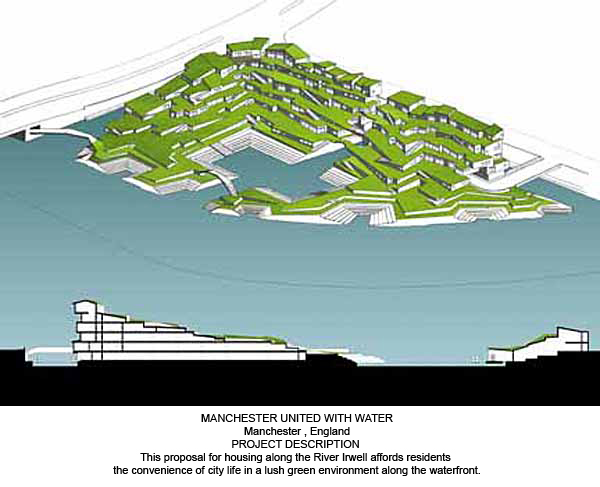
Onto Black and White Gallery in the Terminal Building in Chelsea on 11th Ave and 28th St., we meet up with three artists using clothing in their work: it’s hands-on work with material which seems so manageable, so personal and so private after our discussions of architecture within such a complicated context. Orly Cogan traces sketches of femininity in thread, making stops to embroider some mythic moments, Adam Niklewicz crafts Freudian situations from memory and dreams, and Tamara Kostianovsky creates exposed, animal flesh from girlish clothes. The body is still a funny, mythic and ultimately tragic place.
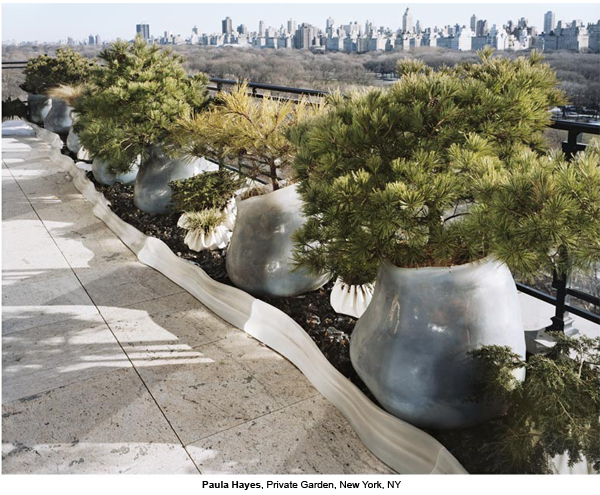
Our last stop is Paula Hayes, a sculptor, thinker and landscape artist whose soft forms containing plants sit on urban rooftops, balconies and in the wilder contexts of suburban landscape. It’s a soft world in here as one translucent bulbous element after another peeks out at us. As she speaks about her art she gently puts on a living necklace, an epiphyte plant that would originally nestle in the
crook of a tropical tree. The boundaries are getting soft again, as she seems to me to change herself into a kind of tree, supporting another species on her skin. Her artworks are messages in bottles she is sending into the future. Tend, nurture, protect, spray with mist, repeat.
But to Wines the idea isn’t enough. The pallet house has been built as a model, but has yet to house or help a population of refugees anywhere in the world. Ideas can begin to seem like a luxury. But what ideas: we get to see many designs of cool urban renovations that have been built and an as yet only imaginary green city complex in Manchester, England, with canals and canal boats that clip right onto the apartments, like floating elevators. Oh, to float my boat.

Onto Black and White Gallery in the Terminal Building in Chelsea on 11th Ave and 28th St., we meet up with three artists using clothing in their work: it’s hands-on work with material which seems so manageable, so personal and so private after our discussions of architecture within such a complicated context. Orly Cogan traces sketches of femininity in thread, making stops to embroider some mythic moments, Adam Niklewicz crafts Freudian situations from memory and dreams, and Tamara Kostianovsky creates exposed, animal flesh from girlish clothes. The body is still a funny, mythic and ultimately tragic place.

